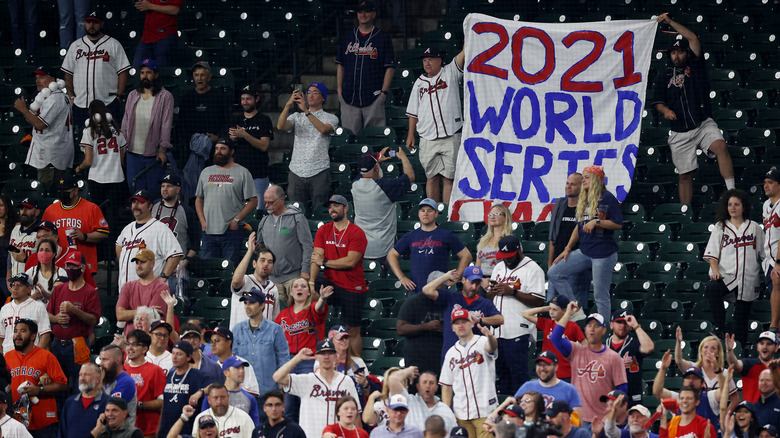Here's Why The World Series Only Takes Place At Night
As any baseball fan knows who has stayed up too late watching their favorite team battle their way toward a championship title, World Series games take place at night exclusively. They often run way past most people's regular bedtimes. This has not always been the case; night games in general were relatively rare for many years. It was just part of the deal that fans who worked during the day would have to sneak in game updates as their schedule allowed — perhaps try to squeeze in a longer lunch and get in a few stolen moments with the radio or television.
In fact, it was the medium of television and its ever-increasing influence on the habits of the American public that led to night games as the default option for championship games. As baseball writer Joe Sheehan reported, "As of October 12, 1971, there had never been a World Series night game. Since October 24, 1987, there has never been a World Series day game. It took 16 years for baseball to turn its crown jewel into just another television program."
The ratings boom and subsequent financial windfall that came when Major League Baseball scheduled night games became obvious in the late 1960s. Per The Washington Post, All-Star Games were first scheduled and broadcast at night in 1967. The ratings were excellent that year and the following year as well.
Fans loved watching games at night
When a rainstorm forced the 1969 All-Star Game to be rescheduled to the following afternoon, the ratings fell significantly, only to rise once again in 1970 when the game was once again played in the evening. Four months later, Major League Baseball scheduled the fourth game of the World Series, between the Pittsburgh Pirates and the Baltimore Orioles, for the night of October 13, 1971.
Commissioner Bowie Kuhn announced the experiment with excitement, telling reporters, "This innovation will make it possible for millions of additional fans to see baseball's postseason classic. I feel the television audience will be of the same dimension that watched the 1970 All-Star Game from Cincinnati" (via National Baseball Hall of Fame). The ratings went well beyond those of the All-Star Game. As reported by the National Baseball Hall of Fame, an estimated 63 million people watched Game 4, then the largest television audience ever for a sports event broadcast during prime time. The game also boasted the highest Nielsen rating that week, beating out popular prime time shows of the day like "All In The Family" and "Hawaii Five-O." Kuhn was, naturally, delighted by Game 4's wild success. He would later note, "When I became commissioner in 1969, the policy was to play most of the World Series games on weekdays. It was a time when most housewives were busy, the children were at school and the men at work. The country's top sports attraction thus was seen by a limited number of people."
Television executives loved night games, too
Kuhn described television network executives as "skeptical and resistant" to night games out of fear of disrupting people's prime time viewing habits for one-off events like the World Series. This, despite encouragement from people within the baseball community. Charles Finley, who was then the owner of the Oakland A's team, pointed out, "We play night baseball all season and then don't even give the loyal fans of our country one night game during the Series. I am sure I have some support in my suggestions that some of the World Series games be played at night to give the working man a chance to attend and greatly increase the size of the television audience" (via the National Baseball Hall of Fame).
In 1985, Peter Ueberroth, who succeeded Kuhn as Major League Baseball's commissioner, announced that series night games were now requisite thanks to the contract with the ABC television network: "The contract predates me. ABC has the right to do that under the contract, and I told the owners I've been informed that we're going to have all night games." The last day game within a World Series took place on October 24, 1987 — it was Game 6 of the series between the St. Louis Cardinals and the Minnesota Twins, and was played indoors at Minnesota's Metrodome, per The Washington Post, meaning no natural light illuminated the historic event.


